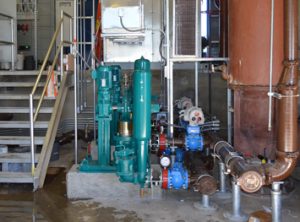
Wastecorp employees read a story posted on YAHOO! from Yahoo and Thames Water’s Website (Thames water is responsible for sewer maintenance in London, England) about a “fatberg” comprised of cooking oil, wet wipes and more which was roughly the size of a Boeing 747. In our weekly global meeting, many on the call contributed to the discussion because in almost every pump markets globally, our customers have to manage either issues relating to cooking oil or solids in the sewer system. The manufacturers of wet wipes worldwide have said that they are researching and developing new products that will help to reduce the clumping issue. But the primary contributor to this problem is not the wet wipes; no one should be dumping cooking oil down the drain – ever. As the YAHOO! article says, when you dump hot cooking oil down the drain into the cold sewer system the fat congeals and clings to anything including the wipes, toilet paper or other solids
Related: Thames Water Press Release about the “Fatberg”
Here is North America; municipal wastewater treatment operators routinely voice their concerns to us about the use of wet pipes by the general public and then flushing them down the toilet. “Do you guys make a pump that can better handle the wet wipes” is a question Wastecorp frequently receives at our sludge pump call centers. Jim K. from Winston Salem North Carolina tells it like it is:
“ All these wet wipes that come into our mid-size WWTP are wreaking havoc on our pumps. We use rotary lobe pumps and progressive cavity pumps and they just clog them causing them to fail and then thousands worth of damage. We need to go a different route. Our city engineer was looking at Wastecorp’s website and suggested we ask about either your plunger pump or double disc pump options.” We need some guidance here please.” Jim K. – Winston Salem, NC
Well Jim, the rotary lobe and progressive cavity companies will sell you the same story: go with our pumps – they’re new. They are leaving out an important fact most lobe and progressive cavity pumps have been around just as long as plunger pumps, (+- 75 years) and most of lobe and progressive cavity pumps don’t do a good job of handling solids. When it comes to plunger pumps, they are a lot less likely to clog. The check balls and pistons move sludge and wet wipes and send them on their way. You should also consider a screen and a grinder in your WWTP process, but having a pump more capable of handling solids will go along way.
Jim, like your city engineer said, many WWTP’s your size have selected either a plunger pump or a double disc pump to manage these wet wipes. We see a lot of facilities your size going the route of the Sludge Master® PE-941 SSIII or our Sludge Pro® 4DDWP™ Double Disc Pump Series. Unless your facility has an endless budget to keep replacing rotors, stators and bearings your facility would be wise to consider other pump options. More info can be found at www.wastecorp.com
